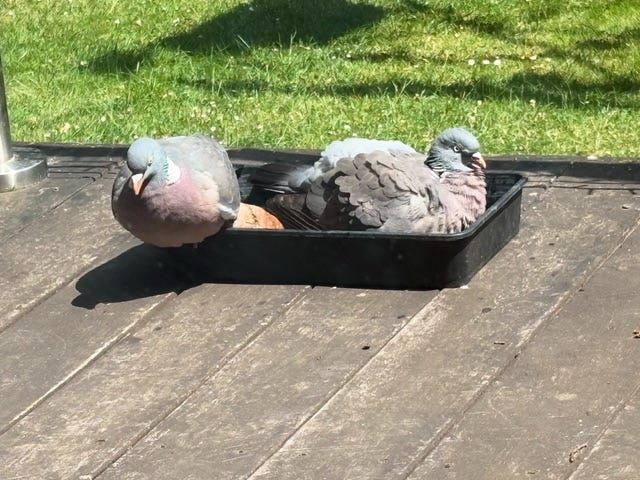The lonely pigeon
A couple of days ago I took this really cute pic of the pigeons that live in my garden, enjoying the water bowl on a sunny afternoon. I say live, I think that should be lived, as one of them has vanished.
For the past couple of days, I have only seen one of them. He (or she) perches on the deck looking very lonely and disconsolate. I think its partner has fallen victim to a cat. There were a lot of feathers in the garden a few days back. Or maybe it was the one that my son and saw a cat drag off half a mile down the road.
Apparently pigeons mate for life, although it seems that if widowed they will find another partner. I do hope this one does.
I can’t help but wonder if the pigeon feels grief. Staying monogamous with one partner suggests a degree of bonding that must cause sadness when broken. It implies a consciousness of other, if not affection in the sense that we understand it. Certainly, when I observed the pair together, they lean their heads on each other in a way that I can only describe as tender.
My lone pigeon came to bathe in the water bowl today. I had the door open and s/he knew I was sitting here writing. He (or she) has also been perching atop the open patio door. It’s almost as if it’s seeking out any kind of company. Or maybe it knows that I chase off cats if I see them in the garden. I’ve started talking to it, like I do to the dogs. It is still wary of me, but doesn’t run away quite as quickly as it was doing.
Tonight s/he is up in the oak tree crooning. I hope that’s the start of trying to find a new mate. But for now, its only avian company is a magpie and a family of parakeets. I think I can hear the robin, but I can’t see him in the foliage.
I think pigeons are very underrated birds. There is a tendancy for humans to see them as flying rats in city centres, always ready to scavenge whatever scraps humans leave for them. But maybe that’s because they’ve adapted to survive in our world. We should respect them for that.
The ones in the garden are a bit like the labradors of the bird world: large, clumsy, very enthusiastic, and not always the sharpest tools in the box. I’ve seen pigeons misjudge their landing, with comical results. One overshot the top of the fence and landed in a heap on the lawn. Another (or maybe the same one?) missed the deck railing and hit the patio door with a thud. It flew off, so I assume it was not hurt.
Just like labradors, pigeons are highly trainable. And racing pigeons are highly prized. A few years back, I notice an unusually tame pigeon in the garden. So tame, it was staying as close to us as it could. Then I noticed a ring on its leg. So I gently caught it. Not difficult, as it didn’t appear able to fly. With it perched on the back of chair indoors, I did a bit of internet research.
From the serial number on the leg band, I deduced it was a racing pigeon. I emailed a local pigeon fanciers group, and got a reply within minutes to try the Leicestershire group, as it was their registration number. The Leicester group clearly passed on my details, as the next day I got a phone call from a chap in the Leicester area, whose pigeon I had in my house. Said pigeon had spent a quiet night in a pet carrier box in the utility room.
Later that evening the gentleman turned up to collect his pigeon, having driven 130 miles after work to get here. He was genuinely happy to be reunited with his bird. He checked him over, and discovered an injury in front of one wing, probably caused by an attack by a bird of prey, quite possibly a red kite in our area.
Apparently the pigeon was on his way home from a release somewhere on the south coast. I’m glad he went home to recover and fly another day. The time I spent with a tame pigeon made me reconsider how I view its wild cousins.




